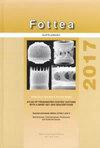Mining salinisation of rivers: its impact on diatom (Bacillariophyta) assemblages
IF 1.4
3区 生物学
Q3 PLANT SCIENCES
引用次数: 9
Abstract
The composition of the diatom assemblages was analysed in four rivers of Upper Silesia, Poland in 2017. The diatom assemblages studied were found to reflect anthropogenic salinization caused by mining activities. The assemblages in those rivers characterised by the highest salinity (Bolina and Mleczna) showed a relatively low taxonomic richness. The diatom assemblages were dominated by species typical of brackish or marine waters. The rivers with a minimal or weak anthropogenic impact (Centuria and Mitrega) supported taxonomically richer diatom assemblages typical of mid-altitude siliceous or calcareous streams (respectively), that have a fine particulate substratum. The presence of a new species, Planothidium nanum sp. nov., was revealed. The new species shows a unique set of morphological characters, including small size; its elliptical outline as well as very widely-spaced central striae on the sternum valve (sinus) and widely-spaced central striae on the raphe valve allow to separate it from other similar Planothidium.河流的采矿盐碱化:对硅藻(硅藻门)组合的影响
2017年,分析了波兰上西里西亚四条河流中硅藻群落的组成。所研究的硅藻组合反映了采矿活动引起的人为盐碱化。以盐度最高为特征的河流(Bolina和Mleczna)中的组合显示出相对较低的分类学丰富度。硅藻群落以微咸水或海水的典型物种为主。人为影响最小或较弱的河流(Centuria和Mitrega)分别支持具有细颗粒基质的中海拔硅质或钙质溪流的分类丰富的硅藻组合。发现了一个新物种,Planothidium nanum sp.nov.的存在。新物种表现出一系列独特的形态特征,包括体型小;它的椭圆形轮廓以及胸骨瓣(窦)上间隔很宽的中央条纹和中缝瓣上间隔很广的中央条纹使它能够与其他类似的Planothidium分离。
本文章由计算机程序翻译,如有差异,请以英文原文为准。
求助全文
约1分钟内获得全文
求助全文
来源期刊

Fottea
生物-植物科学
CiteScore
4.00
自引率
9.10%
发文量
20
审稿时长
>12 weeks
期刊介绍:
Fottea is a journal of Czech Phycological Society (formerly bulletin Czech Phycology). Fottea publishes papers on all aspects of the ecology, physiology, biochemistry, cell biology, molecular biology, systematics and uses of algae (including cyanobacteria)
 求助内容:
求助内容: 应助结果提醒方式:
应助结果提醒方式:


